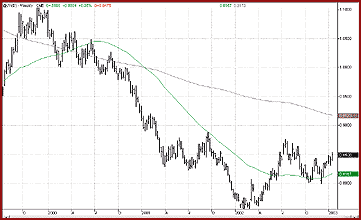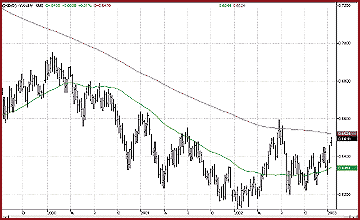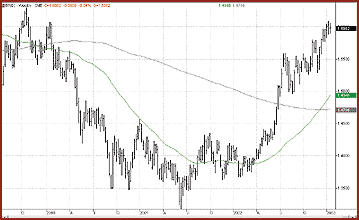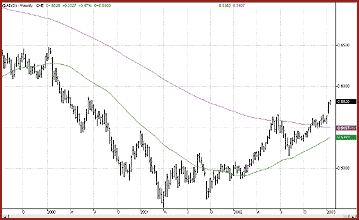JAPANESE YEN

The yen is the third most widely traded currency in the world behind the US dollar and the euro. Unlike some currencies that correlate strongly with commodity production, the yen is much more closely aligned with the strength of the Japanese equity market - as reflected by stock averages such as the Nikkei - as well as the strength of the Japanese real estate market.
The yen has steadily decreased in value since 1995 - a time of rising inflationary concerns in the United States. Efforts to revive the Japanese economy, which suffered both a stock market bubble and a real estate bubble in the late 1980s and has been trapped in a deflationary spiral ever since, have tended to encourage a weaker yen - often to the consternation of trading partners such as the United States and China.
What They Say: "But the paradox of Japan is that the likelihood of positive action on the policy front rises proportionately to the level of overall pessimism, given that crisis conditions are the only things that ever seem to engender action in this politically neutered country." Marshall Auerback, "The Japanese Wild Card," International Perspective, from www.prudentbear.com, January 2003.
CANADIAN DOLLAR

The Canadian dollar is in many ways influenced by the economic fortunes of its neighbor to the south, the United States. However, because Canada is a major commodity producer and exporter, its dollar is also subject to the influence of rising and falling commodity prices. Although not considered among the most widely traded of world currencies, the Canadian dollar is a relatively liquid currency and is often sought by traders and investors looking to diversify their exposure to potential increases in the prices of commodities, including forestry and energy products.
As James Powell notes in his A History of the Canadian Dollar, retreating inflation and a desire to stimulate the economy through lower interest rates were among the major factors contributing to the falling valuation of the Canadian dollar throughout the 1990s. Most recently, the "loonie," as the Canadian dollar is sometimes called, was among the beneficiaries of both a weakening US dollar and firmness in energy prices.
What They Say: "While the Canadian economy was the strongest in the G-7 last year, posting an admirable growth rate of 4.4% in the first three quarters of the year, the US economic recovery faltered. ... Indeed, in Canada we only posted one quarter of negative growth that year, compared to three south of the border. The Canadian economy benefited from the surge in oil prices and the resulting boom in the energy sector." Sherry Cooper, Chief Economist, BMO Nesbitt Burns, from "Risk aversion will dissipate and stocks will benefit," January 2003.
BRITISH POUND

The British pound is one of the major currencies traded in the world, though it trails both the yen and the euro by a distance that has been growing as the use of the euro has spread. After soaring in value during the late 1970s, the pound fell sharply in the early 1980s before rallying again in the second half of the decade. No longer as widely traded in the US and Asia as other currencies, the pound is remembered by many forex traders as the currency that took on legendary speculator George Soros in 1992 - and lost.
The pound is among those currencies that have appreciated significantly against the dollar in the last year and a half. In fact, the poundís technical strength is reflected in its rise above both its 50-week and 200-week moving averages in the first half of 2002. The pound now finds itself in the middle of a price range that was commonplace throughout the 1990s.
The Australian dollar is a commodity-based currency, owing to the sizable role commodity production and export plays in the Australian economy. As such, those looking for exposure to commodity price movements have at times looked to the "aussie" as one way to take advantage of commodity trends - particularly with regard to minerals, farm products, and energy. More recently, some have looked to the Australian dollar as a potential beneficiary of economic growth in Asia, particularly China, which is an increasingly avaricious consumer of raw materials.
Relative to the US dollar, the Australian dollar has been in a long-term, secular bear market. However, there were signs of a reversal in spring 2001 with the Australian dollar trading as low as $0.45 USD. Since that time, the aussie has moved up more than 25%, breaking through its 50-week moving average for good at the beginning of 2002 and besting its 200-week moving average at the beginning of 2003.
What They Say: "Seduced by the double treat of currency gain and high yields, offshore investors continue to scoop up Australian dollars. The currency touched a fresh two-year high of US 58.70 cents yesterday, helped by a limp US dollar, and had one-month peaks against the euro and the yen earlier this week. Investors held fast to long-term expectations that expansionary fiscal and monetary policies in major industrialized countries will make 2003 the year of growth, a boon for the commodity-linked $A." Corinne Lim, "Hungry buyers gobble up dollar," Australian Dollar Wrap, Australian Financial Review, January 2003.
"Over the past 10 years, London has boomed. The metropolitan economy - larger than that of several European states - has outperformed the rest of the British economy by a long way. But signs are multiplying that the London economy is flirting with recession." "Metropolitan gloom," from The Economist, January 11, 2003.
AUSTRALIAN DOLLAR

The Australian dollar is a commodity-based currency, owing to the sizable role commodity production and export plays in the Australian economy. As such, those looking for exposure to commodity price movements have at times looked to the "aussie" as one way to take advantage of commodity trends - particularly with regard to minerals, farm products, and energy. More recently, some have looked to the Australian dollar as a potential beneficiary of economic growth in Asia, particularly China, which is an increasingly avaricious consumer of raw materials.
Relative to the US dollar, the Australian dollar has been in a long-term, secular bear market. However, there were signs of a reversal in spring 2001 with the Australian dollar trading as low as $0.45 USD. Since that time, the aussie has moved up more than 25%, breaking through its 50-week moving average for good at the beginning of 2002 and besting its 200-week moving average at the beginning of 2003.
What They Say: "Seduced by the double treat of currency gain and high yields, offshore investors continue to scoop up Australian dollars. The currency touched a fresh two-year high of US 58.70 cents yesterday, helped by a limp US dollar, and had one-month peaks against the euro and the yen earlier this week. Investors held fast to long-term expectations that expansionary fiscal and monetary policies in major industrialized countries will make 2003 the year of growth, a boon for the commodity-linked $A." Corinne Lim, "Hungry buyers gobble up dollar," Australian Dollar Wrap, Australian Financial Review, January 2003.
Originally published in the March 2003 issue of Technical Analysis of STOCKS & COMMODITIES magazine. All rights reserved. © Copyright 2003, Technical Analysis, Inc.